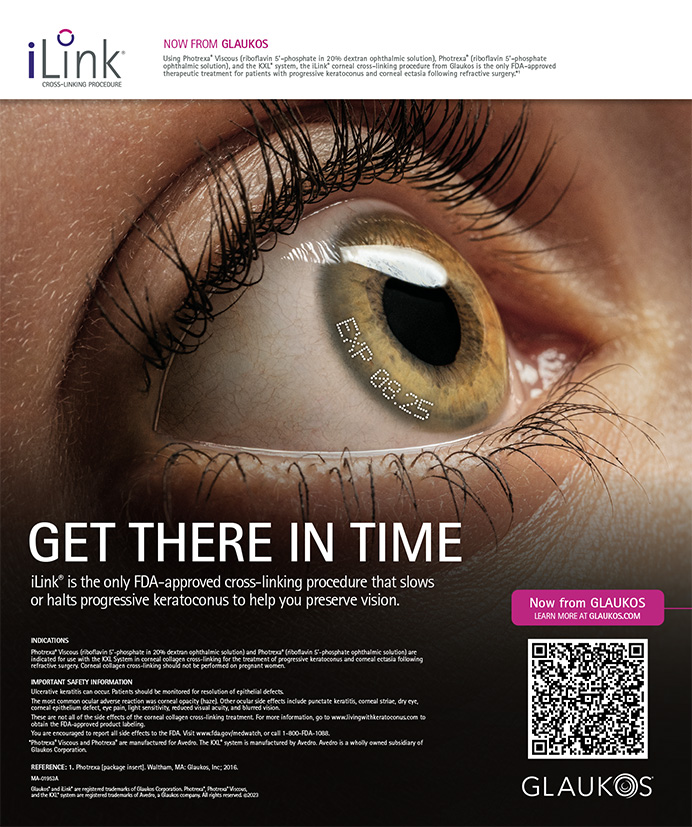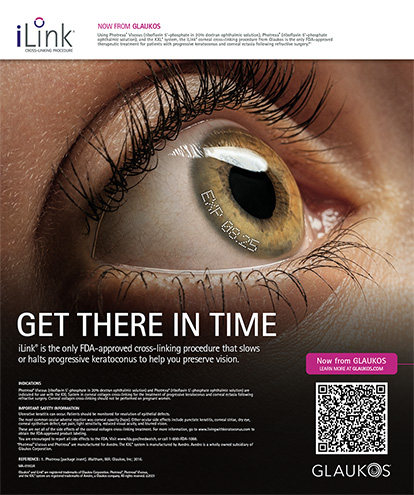Laser vision correction has two significant advantages over limbal relaxing incisions for the treatment of residual ametropia after cataract surgery, particularly with premium-channel IOLs. The precision of laser vision correction is superior to that of incisional surgery, and spherical—as well as astigmatic—corrections can be made simultaneously.
Compared with LASIK, PRK does not cut as many corneal nerves, leading to less postoperative dry eye. Moreover, PRK can be performed on a wider range of patients after phacoemulsification, including those with previous RK in whom LASIK might destabilize the cornea or increase their risk of epithelial ingrowth. Additionally, the eyelids of mature patients are not spread as widely during PRK compared with LASIK, leading to less postoperative lagophthalmos. Finally, the cataract surgeon can competently perform PRK even when his or her volume of patients is very low; the same is not true for LASIK.
EXTERNAL DISEASE
The older, cataract population is likely to have some element of external disease (eg, dry eye, blepharitis, and/or lagophthalmos). The surgeon should look for these conditions and treat them vigorously prior to the phaco surgery and certainly prior to the laser vision correction enhancement surgery. There is now evidence that addressing these conditions will lead to better refractive and visual outcomes, faster recovery, and fewer complications.
Dry Eye
For all but the mildest cases of dry eye, I have patients start cyclosporine emulsion (Restasis; Allergan, Inc.) b.i.d. for at least 1 month before PRK, along with gently preserved or unpreserved tears q.i.d. to eight times a day, a bland ointment at night (Refresh PM; Allergan, Inc.), and nutritional supplementation with omega-3 fatty acids. I also prescribe loteprednol etabonate drops (Lotemax; Bausch + Lomb) q.i.d. for 2 weeks, then b.i.d. for 2 weeks when starting Restasis therapy. This topical steroid blunts or eliminates the stinging that some patients feel at the start of cyclosporine therapy, and it gives them immediate symptomatic relief. I will see these patients again in 4 to 6 weeks and assess their need for punctal plugs. More often than not, I place four (occasionally only two) plugs.
Blepharitis
For blepharitis, I recommend that the patient use soaks and scrubs b.i.d. Individuals with moderate-tosevere cases also rub Azasite (azithromycin 1% solution; Inspire Pharmaceuticals, Inc.) into their eyelid margins once or twice daily, depending on the severity of the blepharitis. In addition to the measures already described, patients with severe blepharitis take oral doxycycline hyclate 20 mg every day.
PRK WORKUP
On the next visit, about 4 to 6 weeks after the aforementioned therapies have been started, if the patient’s ocular health is much improved and if there is no central corneal staining and mild or minimal conjunctival staining with lissamine green, I will perform the preoperative PRK workup. The order in which the tests are performed is critical: tests that are noncontact and of the most importance are done first, while the precorneal tear film is still pristine. Therefore, wavefront analysis and topography are the first two tests performed. If a Pentacam Comprehensive Eye Scanner (Oculus, Inc., Lynnwood, WA) or an Orbscan topographer (Bausch + Lomb, Rochester, NY) is available, I use them to obtain a map of the corneal thickness. If these devices are not available, a handheld ultrasonic pachymeter can be used to measure corneal thickness in five spots (ie, central, midsuperior, midinferior, midtemporal, and midnasal), but only after the cycloplegic refraction is performed.
Refraction and Dilation
I perform the manifest refraction and assess the size of the patient’s mesopic pupil and his or her ocular dominance. IOP measurements are next, followed by pupillary dilation with one drop each of neosynephrine, tropicamide, and cyclogyl. Three doses of cyclogyl are given 5 minutes apart. Forty-five minutes after the third dose of cyclogyl, I perform the cycloplegic refraction and a fundus examination.
Some physicians may say that it is unnecessary to perform a cycloplegic refraction on a pseudophakic patient, but I disagree. Certain monofocal and multifocal IOLs (and, of course, accommodating lenses) will move slightly with accommodative effort; the patient may actually be attempting to accommodate during most of his or her waking hours, even for distance. Although this situation is unlikely, it is important to be aware of it.
Manifest Refraction
If the wavefront map is in close agreement with the manifest refraction, it is safe to use it as the basis for treatment. This is particularly true with accommodating and diffractive multifocal IOLs. It is generally not a good idea to use the wavefront map to treat patients with refractive multifocal IOLs, because the wavefront device may detect the intermediate or near zone of the IOL instead of the distance zone. If in doubt, it is always safest to use a standard treatment.
SURGERY
The patient is sedated with diazepam (usual dose, 10 mg by mouth exactly 30 minutes before the laser fires) along with the first dose of prednisone, as described below. I adjust this dose based on body weight and age, so I use 5 mg for the elderly and those under 110 lbs. A sedated patient will fixate much better than a nervous one and will fight the speculum less. Post-PRK ptosis has been reported in the literature, due to anxious patients’ stripping their levator aponeuroses while fighting the speculi.
It is important to bring the patient into the suite in a calm and quiet fashion and to make him or her comfortable. Because the laser suite is cold, we offer a nonshedding blanket and a teddy bear or squeeze ball for the patients to clutch. Older patients will especially appreciate a pillow under their knees, as it supports their spinal columns.
Positioning
perfectly straight and in line with the surgeon’s, the head is straight, and the chin is not tucked. Some lasers, such as the Visx Star S4 (Abbott Medical Optics Inc., Santa Ana, CA), have an optional fiduciary line that can be projected onto the patient’s nose as an aid in head positioning. The patient’s eye receives three drops of a topical anesthetic during the minute before surgery begins. The lids are cleaned, the lashes draped with Tegaderm (3M, St. Paul, MN), and the speculum is inserted. When the patient and surgeon agree that the eye is directly in the center of the surgical field (as seen through the microscope) and just beneath the flashing fixation light (patient’s view), the microscope is put into fine focus on the apex of the cornea. This is done under high magnification; then, the magnification is lowered.
As a “time out,” the technician should read the patient’s name aloud as well as the eye to be treated and the parameters about to be treated (eg, diopters, diameter of treatment, etc.). A circular RK-style marker that has been inked with methylene blue is used to mark the treatment zone as the patient fixates on the flashing light. The central epithelium should be removed only within this outlined area, with as little extra epithelium removed as possible, to shorten the time to complete re-epithelialization.
Epithelial Removal
Epithelial removal can be accomplished with an Amoils brush (Innovative Excimer Solutions Inc., Toronto, Ontario, Canada), alcohol exposure and then mechanical debridement, or by using mechanical debridement only. I prefer the third method, using only a Tooke knife (ie, a slightly sharp spatula). I do not use the brush because it crushes every corneal epithelial cell, theoretically releasing extra proinflammatory cytokines. Eyes treated with alcohol tend to have a mild iritis postoperatively, although all three methods are in common use today.
Immediately after I remove the central epithelium, I wash the surface with very cold balanced salt solution. I pat the central surface with a dry Weck-Cel spear (Medtronic ENT, Jacksonville, FL), get the microscope into final critical focus, engage eye tracking, and (with the Visx Star S4 laser) activate iris registration for cases in which a wavefront treatment will be performed. I talk to the patient throughout the short ablation period; the technician announces the countdown every 5 seconds as well. Patients love to hear the countdown, as they want to know how many seconds they need to concentrate on the fixation light. I encourage them and praise them during the ablation period.
AFTER SURGERY
Upon completion of the last laser shot, cold balanced salt solution is squirted immediately onto the ablation zone by a technician hovering at my side. Although some patients dislike the associated “ice cream headache,” the application of cold is effective at reducing postoperative pain. A bandage soft contact lens is then placed on the eye; I am fond of the Acuvue Oasys lenses (Johnson & Johnson, New Brunswick, NJ). I apply a fluoroquinolone antibiotic, a nonsteroidal anti-inflammatory drug, and a steroid topically.
Cold Pack
The patient is moved to an examination lane, where the chair is reclined into the horizontal position. The patient lies there for 10 minutes with a cold pack placed over the treated eye. He or she goes home with an extra cold mask that can be placed in the freezer so that the patient can alternate them as needed for the next 24 hours.
My post-PRK regimen decreases postoperative pain and enhances visual recovery. A key element is a 6-day tapering course of oral steroids (see Presurgical Instructions) but only for patients who do not have diabetes. For individuals older than 50 years, I scale back on the starting dose by 20 mg or more and occasionally taper the drug more quickly.
Follow-Up
There are two quick postoperative visits on days 1 and 3 or 4; at the third visit on day 6 or 7, the bandage contact lens is removed. The next visits are at 1 and 3 months, and the need for an enhancement is assessed at 3 months. With modern technology and perioperative regimens, the percentage of patients needing enhancement surgery is less than 7% in most practices.
Marguerite B. McDonald, MD, is a cornea/refractive specialist with the Ophthalmic Consultants of Long Island in Lynbrook, New York, a clinical professor of ophthalmology at the NYU Langone Medical Center in New York City, and an adjunct clinical professor of ophthalmology at the Tulane University Health Sciences Center in New Orleans. She is a consultant to Abbott Medical Optics Inc.; Allergan, Inc.; and Inspire Pharmaceuticals, Inc. Dr. McDonald may be reached at (516) 593-7709; margueritemcdmd@aol.com.


